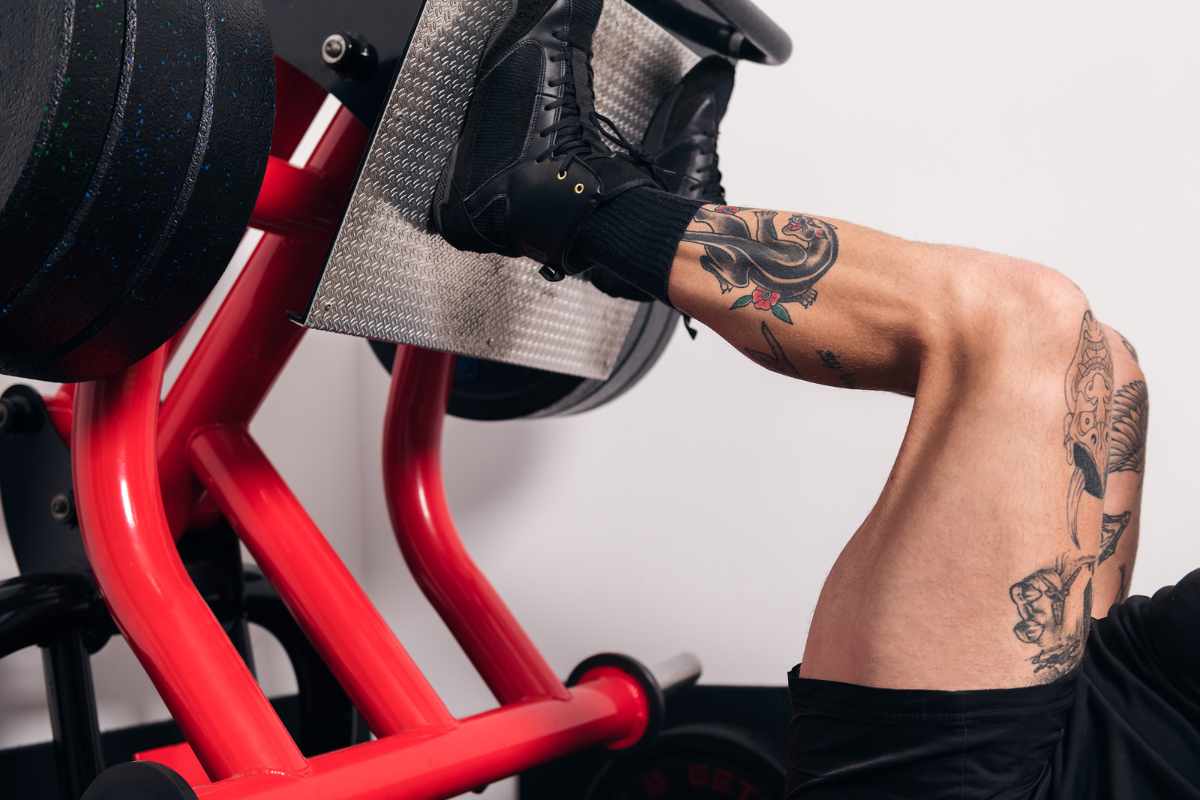Home>Health and Wellness>The Surprising Truth: Smith Machine Vs. Squat Rack – Which Is The Ultimate Fitness Game Changer?


Health and Wellness
The Surprising Truth: Smith Machine Vs. Squat Rack – Which Is The Ultimate Fitness Game Changer?
Published: January 24, 2024
Discover the ultimate game changer for your health and wellness with this in-depth comparison of the Smith machine and squat rack. Uncover the surprising truth and make the right choice for your fitness journey.
(Many of the links in this article redirect to a specific reviewed product. Your purchase of these products through affiliate links helps to generate commission for Noodls.com, at no extra cost. Learn more)
Table of Contents
Introduction
When it comes to weight training, the debate between the Smith machine and the squat rack has sparked numerous discussions among fitness enthusiasts. Both pieces of equipment are commonly found in gyms and play a pivotal role in strength training routines. The Smith machine, with its guided barbell, offers a sense of stability and control, while the squat rack provides a more traditional, free-weight approach to performing squats and other exercises.
In this article, we will delve into the key differences between the Smith machine and the squat rack, exploring their respective benefits, drawbacks, and impact on muscle activation. By gaining a deeper understanding of these two fitness tools, you will be better equipped to make an informed decision about which one best aligns with your fitness goals and preferences.
So, let's embark on this journey to uncover the surprising truth behind the Smith machine and the squat rack. Whether you're a seasoned gym-goer or just starting your fitness journey, this exploration will provide valuable insights to help you maximize your workouts and achieve your fitness aspirations.
Understanding the Smith Machine
The Smith machine is a piece of weight training equipment that consists of a barbell fixed within steel rails, allowing for vertical movement along a guided path. This design provides a controlled and stabilized environment for performing various exercises, including squats, bench presses, shoulder presses, and lunges. The machine's structure comprises a series of hooks and safety latches, enabling users to adjust the bar to their desired height and secure it in place during workouts.
One of the defining features of the Smith machine is its guided motion, which can be advantageous for individuals who are new to weightlifting or those seeking additional support when performing exercises. The fixed barbell path helps users maintain proper form and stability, reducing the risk of injury during movements such as squats and bench presses. This controlled range of motion can also be beneficial for targeting specific muscle groups and enhancing muscle engagement, particularly for those who may struggle with balance or have limitations due to previous injuries.
Additionally, the Smith machine offers versatility in exercise options, allowing individuals to perform a wide range of movements without the need for a spotter. This aspect makes it an attractive choice for solo workouts or times when a training partner is not available. Moreover, the machine's built-in safety features, such as adjustable safety stops and lockout points, contribute to a sense of security and confidence for users, especially when lifting heavier weights.
However, it's important to note that while the Smith machine provides a controlled environment for weight training, some fitness enthusiasts argue that the guided barbell path may limit the body's natural range of motion during exercises. This restriction could potentially lead to muscle imbalances or decreased activation of stabilizing muscles, which are crucial for overall strength and functional fitness. Therefore, understanding the balance between the stability offered by the Smith machine and the need for functional movement patterns is essential for making informed decisions about incorporating it into a workout routine.
In summary, the Smith machine offers a structured and secure platform for performing a variety of exercises, making it a suitable option for individuals who prioritize stability and safety during weight training. Its guided barbell path and built-in safety features can provide valuable support for beginners and those seeking additional reassurance during workouts. However, it's essential to consider the potential impact on natural movement patterns and muscle engagement when utilizing this equipment as part of a comprehensive strength training program.
Understanding the Squat Rack
The squat rack, also known as a power rack or squat cage, is a fundamental piece of equipment in weight training, particularly for performing squats and other compound movements. It typically consists of four vertical posts with adjustable horizontal bars, creating a sturdy framework that supports the execution of various exercises. Unlike the guided motion of the Smith machine, the squat rack offers an open and unrestrictive environment, allowing for natural and unrestricted movement patterns during workouts.
One of the primary advantages of the squat rack is its versatility and adaptability to accommodate different body types and exercise variations. The adjustable horizontal bars enable users to set the barbell at a suitable height, catering to individual preferences and lifting capabilities. This flexibility is especially beneficial for performing squats, as it allows for a full range of motion while maintaining proper form and alignment.
Moreover, the squat rack promotes functional strength development by engaging stabilizing muscles and enhancing overall balance and coordination. Unlike the guided path of the Smith machine, the open design of the squat rack encourages the body to stabilize itself throughout the movement, leading to improved muscle activation and a more comprehensive workout experience. This aspect is particularly advantageous for individuals aiming to enhance their functional fitness and carry over strength gains to real-life activities and sports.
Furthermore, the squat rack fosters a sense of empowerment and self-reliance during workouts, as it requires users to develop proficiency in setting up the equipment and performing exercises without the constraints of a guided barbell path. This self-sufficiency can contribute to a greater sense of accomplishment and confidence in one's strength training journey, fostering a deeper connection with the workout process.
However, it's important to acknowledge that utilizing the squat rack requires a certain level of experience and familiarity with proper lifting techniques. Given the absence of a guided barbell path, users must prioritize form and safety to prevent injury and maximize the benefits of their workouts. Additionally, having a spotter or using safety bars when lifting heavy weights is recommended to ensure a secure and controlled lifting environment.
In summary, the squat rack offers a versatile and empowering platform for performing a wide range of exercises, particularly squats, within an open and unrestricted setting. Its emphasis on natural movement patterns, functional strength development, and user autonomy makes it an invaluable tool for individuals seeking a comprehensive and dynamic approach to strength training. Understanding the unique benefits and considerations associated with the squat rack can guide fitness enthusiasts in making informed decisions about incorporating it into their workout routines.
The Benefits of the Smith Machine
The Smith machine offers a myriad of benefits that cater to individuals with varying fitness levels and training objectives. One of its primary advantages lies in the provision of a controlled and stabilized environment for weight training. This aspect is particularly beneficial for beginners who are new to resistance exercises or individuals seeking additional support during their workouts. The guided barbell path of the Smith machine assists users in maintaining proper form and alignment, reducing the risk of injury and promoting a sense of confidence and security during movements such as squats, bench presses, and lunges.
Moreover, the Smith machine's structured design and built-in safety features, including adjustable safety stops and lockout points, contribute to a sense of reassurance for users, especially when lifting heavier weights. This aspect not only enhances the overall safety of workouts but also instills a greater level of confidence, allowing individuals to push their limits and challenge themselves without compromising on security.
In addition to its safety benefits, the Smith machine offers versatility in exercise options, making it an attractive choice for solo workouts or times when a training partner is not available. The machine's guided barbell path enables users to perform a wide range of movements without the need for a spotter, promoting independence and self-sufficiency during training sessions.
Furthermore, the controlled range of motion provided by the Smith machine can be advantageous for targeting specific muscle groups and enhancing muscle engagement. This aspect is particularly valuable for individuals who may struggle with balance or have limitations due to previous injuries, as the machine's stabilized environment allows for targeted muscle activation without compromising on safety.
Overall, the Smith machine's benefits encompass its ability to provide a secure and structured platform for weight training, catering to the needs of beginners, seasoned gym-goers, and individuals with specific fitness considerations. Its guided barbell path, safety features, and exercise versatility make it a valuable asset in strength training routines, offering a supportive and empowering environment for individuals to pursue their fitness goals with confidence and determination.
The Benefits of the Squat Rack
The squat rack stands as a cornerstone of strength training, offering a multitude of benefits that cater to individuals striving for functional strength, versatility, and self-reliance in their fitness journey. One of its primary advantages lies in the open and unrestrictive environment it provides for performing a wide range of exercises, with a particular emphasis on squats and compound movements. Unlike the guided motion of the Smith machine, the squat rack's design fosters natural and unrestricted movement patterns, allowing users to engage in full-body workouts that promote functional strength and overall balance.
The versatility of the squat rack is a standout feature, as it accommodates various body types and exercise variations through its adjustable horizontal bars. This adaptability enables users to set the barbell at an optimal height, aligning with individual preferences and lifting capabilities. As a result, individuals can engage in squats and other exercises with a full range of motion, promoting proper form and alignment while targeting multiple muscle groups simultaneously.
Moreover, the open design of the squat rack encourages the body to stabilize itself throughout movements, leading to improved muscle activation and enhanced functional fitness. By engaging stabilizing muscles and promoting balance and coordination, the squat rack facilitates a comprehensive workout experience that extends beyond isolated muscle development, aligning with real-life activities and sports.
The squat rack also fosters a sense of empowerment and self-reliance during workouts, as it requires users to develop proficiency in setting up the equipment and executing exercises without the constraints of a guided barbell path. This self-sufficiency not only contributes to a greater sense of accomplishment but also instills confidence and a deeper connection with the strength training process.
However, it's crucial to acknowledge that utilizing the squat rack necessitates a level of experience and familiarity with proper lifting techniques. Given the absence of a guided barbell path, users must prioritize form and safety to prevent injury and maximize the benefits of their workouts. Additionally, having a spotter or using safety bars when lifting heavy weights is recommended to ensure a secure and controlled lifting environment.
In summary, the squat rack offers a versatile and empowering platform for individuals seeking a comprehensive and dynamic approach to strength training. Its emphasis on natural movement patterns, functional strength development, and user autonomy makes it an invaluable tool for fitness enthusiasts striving for a holistic and empowering workout experience. Understanding the unique benefits and considerations associated with the squat rack can guide individuals in making informed decisions about incorporating it into their strength training routines.
Drawbacks of the Smith Machine
While the Smith machine offers several advantages, it is important to acknowledge its limitations and potential drawbacks that may impact an individual's strength training experience. Understanding these aspects is crucial for making informed decisions about incorporating the Smith machine into a workout routine.
One of the primary drawbacks of the Smith machine is its potential to restrict natural movement patterns during exercises. The guided barbell path, although providing stability and control, may limit the body's range of motion, leading to concerns about muscle imbalances and decreased activation of stabilizing muscles. This restriction can hinder the development of functional strength and overall mobility, which are essential components of a well-rounded fitness regimen.
Additionally, the fixed nature of the Smith machine's barbell path may not fully align with the body's biomechanics and individual variations in movement. This mismatch between the machine's predetermined path and the body's natural mechanics can impact exercise effectiveness and overall muscle engagement, potentially compromising the holistic benefits of strength training.
Furthermore, some fitness enthusiasts raise concerns about the potential overreliance on the Smith machine's support and stabilization, which could result in decreased activation of core and stabilizing muscles. The machine's guided nature may inadvertently diminish the body's need to engage these crucial muscle groups for balance and stability, potentially impacting overall functional fitness and performance in real-world activities.
Another notable drawback is the reduced requirement for proprioception and coordination when using the Smith machine. Proprioception, the body's ability to sense its position in space, and coordination are essential components of effective strength training, contributing to improved movement quality and injury prevention. The structured environment of the Smith machine may limit the development of these vital skills, potentially affecting an individual's overall physical competence and movement proficiency.
In summary, while the Smith machine offers a controlled and secure platform for weight training, it is essential to recognize its drawbacks, including potential restrictions on natural movement patterns, concerns about muscle engagement and functional strength development, and the impact on proprioception and coordination. By understanding these limitations, individuals can make informed choices about integrating the Smith machine into their strength training routines while considering the need for a balanced approach that encompasses natural movement, functional strength, and overall physical competence.
Drawbacks of the Squat Rack
While the squat rack offers a multitude of benefits for strength training, it is important to recognize the potential drawbacks and considerations associated with its utilization. Understanding these aspects is crucial for individuals seeking to incorporate the squat rack into their workout routines and make informed decisions about their fitness journey.
One of the primary drawbacks of the squat rack revolves around the necessity for a certain level of experience and familiarity with proper lifting techniques. Unlike the guided barbell path provided by the Smith machine, the open and unrestricted environment of the squat rack requires users to prioritize form, safety, and proper execution of exercises. This aspect implies that individuals, especially those new to weightlifting, must invest time and effort in learning and mastering the correct lifting techniques to prevent injury and maximize the benefits of their workouts.
Additionally, the absence of a guided barbell path in the squat rack may pose challenges for individuals in maintaining proper form and alignment, particularly when lifting heavier weights. Without the stabilizing support offered by the Smith machine, users must rely on their own coordination and muscular engagement to execute exercises effectively. This aspect emphasizes the importance of developing proficiency in stabilizing muscles and balance, highlighting the need for a comprehensive approach to strength training that encompasses both guided and open environments.
Furthermore, while the open design of the squat rack promotes natural movement patterns and functional strength development, it also necessitates a heightened level of awareness and attentiveness during workouts. Without the constraints of a guided barbell path, users must continuously focus on maintaining proper form and stability throughout the exercises, emphasizing the need for mindfulness and concentration during training sessions.
Moreover, the self-reliance and autonomy encouraged by the squat rack, while empowering for experienced lifters, may pose challenges for individuals who require additional support or reassurance during their workouts. The absence of a guided barbell path and built-in safety features, such as those found in the Smith machine, places greater responsibility on the user to ensure a secure and controlled lifting environment, emphasizing the need for careful consideration and preparation when utilizing the squat rack for strength training.
In summary, while the squat rack offers a versatile and empowering platform for strength training, it is important to acknowledge the potential drawbacks associated with its open and unrestricted environment. These considerations encompass the need for experience and familiarity with proper lifting techniques, challenges in maintaining form and alignment, the requirement for heightened awareness during workouts, and the responsibility placed on the user for a secure and controlled lifting environment. By understanding these limitations, individuals can approach the integration of the squat rack into their strength training routines with a balanced perspective, emphasizing the need for a comprehensive approach that encompasses both guided and open environments to maximize the benefits of their workouts.
Comparing Muscle Activation
When comparing muscle activation between the Smith machine and the squat rack, it's essential to understand how each piece of equipment influences the engagement of various muscle groups during strength training exercises. The guided barbell path of the Smith machine and the open environment of the squat rack present distinct impacts on muscle activation, targeting different stabilizing muscles and movement patterns.
In the case of the Smith machine, the guided barbell path provides a controlled and stabilized environment for exercises such as squats, bench presses, and lunges. This controlled range of motion can lead to heightened activation of primary muscle groups, including the quadriceps, hamstrings, glutes, and chest muscles. The machine's stability and built-in safety features allow users to focus on targeting these muscle groups without the need to stabilize the weight, potentially leading to increased muscle engagement and strength development in these areas.
On the other hand, the squat rack's open design promotes natural movement patterns and functional strength development, engaging a broader range of stabilizing muscles throughout exercises. The need for maintaining balance and stability without the constraints of a guided barbell path leads to enhanced activation of core muscles, lower back muscles, and stabilizers throughout the shoulders and arms. Additionally, the requirement for coordination and proprioception in the squat rack environment further contributes to comprehensive muscle activation, fostering a more holistic approach to strength training.
Furthermore, the squat rack's emphasis on full-body movements, such as squats and overhead presses, encourages integrated muscle activation, targeting multiple muscle groups simultaneously. This integrated approach promotes functional strength development and overall balance, aligning with real-world movement patterns and activities.
In contrast, the Smith machine's guided motion may prioritize isolated muscle activation, potentially limiting the engagement of stabilizing muscles and the development of integrated strength. While the machine offers targeted muscle activation and support for individuals with specific limitations or concerns, it may not fully encompass the comprehensive muscle engagement and functional strength development facilitated by the squat rack's open and unrestricted environment.
In summary, the comparison of muscle activation between the Smith machine and the squat rack reveals distinct influences on primary and stabilizing muscle groups. The Smith machine's controlled environment may lead to targeted muscle engagement, while the squat rack's open design promotes integrated muscle activation and functional strength development. Understanding these differences is crucial for individuals seeking to optimize their strength training routines and target specific muscle groups effectively based on their fitness goals and preferences.
Safety Considerations
Ensuring safety during strength training is paramount, regardless of the equipment used. Both the Smith machine and the squat rack present unique safety considerations that individuals should carefully address to minimize the risk of injury and optimize their workout experiences.
When utilizing the Smith machine, users benefit from its guided barbell path and built-in safety features, including adjustable safety stops and lockout points. These elements contribute to a secure and controlled lifting environment, reducing the likelihood of accidents or mishaps during exercises such as squats, bench presses, and lunges. However, it is crucial for individuals to adjust the safety stops to an appropriate height based on their range of motion and lifting capabilities, ensuring that the equipment provides adequate support while allowing for proper form and movement.
Additionally, users should be mindful of the potential overreliance on the Smith machine's stabilization and support. While the machine offers a sense of security, it is essential for individuals to engage their core and stabilizing muscles to maintain balance and stability throughout exercises. This proactive approach not only enhances overall muscle engagement but also contributes to the development of functional strength and movement proficiency, aligning with a holistic approach to strength training.
In contrast, the squat rack requires users to prioritize form, coordination, and proper lifting techniques to ensure safety and effectiveness during workouts. Individuals should familiarize themselves with setting up the equipment, including adjusting the horizontal bars to an appropriate height, and develop proficiency in executing exercises with proper form and alignment. Moreover, having a spotter or using safety bars, especially when lifting heavier weights, is advisable to provide an added layer of security and reassurance.
Furthermore, individuals utilizing the squat rack should maintain heightened awareness and attentiveness during workouts, focusing on maintaining stability and balance throughout exercises. Mindfulness and concentration play a crucial role in preventing accidents and promoting safe lifting practices, emphasizing the need for a disciplined and attentive approach to strength training.
Both the Smith machine and the squat rack necessitate a comprehensive understanding of proper lifting techniques, form, and safety measures to ensure a secure and controlled workout environment. By addressing these safety considerations and integrating them into their strength training routines, individuals can optimize their workouts while minimizing the risk of injury, fostering a safe and empowering fitness experience.
Conclusion
In conclusion, the comparison between the Smith machine and the squat rack unveils a nuanced landscape of benefits, drawbacks, and considerations that significantly impact strength training experiences. The Smith machine, with its guided barbell path and built-in safety features, offers a structured and secure platform for weight training, catering to individuals seeking stability and support during exercises. Its versatility and ability to target specific muscle groups make it an attractive choice for beginners and seasoned gym-goers alike. However, the potential restrictions on natural movement patterns and concerns about muscle engagement necessitate a balanced approach to its incorporation into strength training routines.
On the other hand, the squat rack stands as a symbol of versatility and empowerment in strength training, fostering natural movement patterns, functional strength development, and user autonomy. Its open and unrestricted environment encourages a comprehensive approach to muscle activation, targeting primary and stabilizing muscle groups while promoting balance and coordination. However, the necessity for experience and familiarity with proper lifting techniques, heightened awareness during workouts, and the responsibility placed on the user for a secure and controlled lifting environment underscore the need for a mindful and attentive approach to utilizing the squat rack.
When considering muscle activation, the Smith machine's controlled environment may lead to targeted muscle engagement, while the squat rack's open design promotes integrated muscle activation and functional strength development. Understanding these differences is crucial for individuals seeking to optimize their strength training routines and target specific muscle groups effectively based on their fitness goals and preferences.
In terms of safety considerations, both the Smith machine and the squat rack demand a comprehensive understanding of proper lifting techniques, form, and safety measures to ensure a secure and controlled workout environment. By addressing these safety considerations and integrating them into their strength training routines, individuals can optimize their workouts while minimizing the risk of injury, fostering a safe and empowering fitness experience.
Ultimately, the choice between the Smith machine and the squat rack hinges on individual preferences, fitness goals, and the need for a balanced approach to strength training. By recognizing the unique benefits and considerations associated with each piece of equipment, individuals can make informed decisions that align with their aspirations for strength, fitness, and overall well-being. Whether seeking stability and support or prioritizing natural movement patterns and functional strength development, both the Smith machine and the squat rack offer valuable avenues for individuals to pursue their fitness journeys with confidence and determination.













